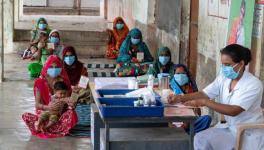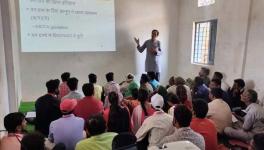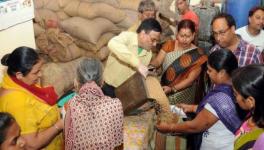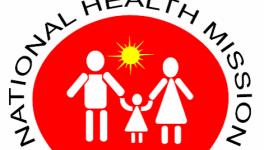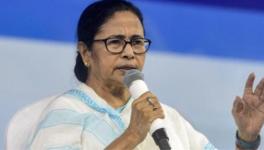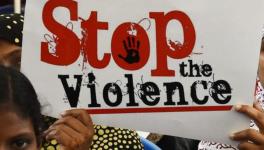Budget 2023-24: Leaving the Marginalised Behind!
Representational use only.Image Courtesy: Flickr
The speech of the last full-fledged Union budget of the current government, termed by Finance Minister Nirmala Sitharaman as the first budget of the ‘Amrit Kaal’, starts with declaring a vision of a “prosperous and inclusive” India. In this time of high unemployment, declining real rural wages and increasing inequality and when people are still not fully recovered from the effects of Corona, the focus on inclusion is extremely important. A report published by the Development Monitoring and Evaluation Office of the NITI Ayog in 2021 highlights the need for inclusion.
“SCs, STs, OBCs, Safai Karamcharis, Denotified Tribes (DNTs), Notified Tribes (NTs) and Seminotified Tribes (SNTs) belong to the poorest economic strata of Indian society and face severe economic and social exclusion, segregation in housing, denial, and restrictions of access to public and private services and employment,” the report read.
The same report also suggests that STs, SCs and Muslims have lower economic assets than the average households.
India is also committed to the Sustainable Development Goals (SDGs), which will be achieved by 2030. Leaving No One Behind is the motto of the United Nations for achieving the SDGs, indicating the need for the inclusion of marginalised people and communities in the achievements of the SDGs. The NITI Ayog also brings out an annual report to track the country’s progress on SDGs. As per the last report, India’s scored 66 out of 100.
Therefore, it is necessary to focus on inclusion in the budget. However, the fine details of the budget do not seem to support the focus on inclusion. The budget of the key ministries focusing on the empowerment of marginalised communities has not increased substantially. The table below presents the data on the budget for the ministries of social justice and empowerment, tribal affairs, minority affairs and women and child development.
Budget for the ministries for Marginalised Communities (SC, ST, Minority, PWD, Women & Child Development) (Rs in Crore)
Source: Union Budget, various years, available on www.indiabudget.gov.in
As the table above shows, except for the Ministry of Tribal Affairs, there is no increase in the budget of these key ministries for the marginalised people. Allocations to the Dept. of Empowerment of People with Disabilities and the Ministry of Women and Child Development remain almost the same as the current year’s budget. In contrast, there is an increase of about 7.75% in the budget for the department of Social Justice and Empowerment, catering to the Dalits, Elderly, Denotified and Nomadic Tribes (DTNT) and other marginalised groups.
The increase in the budget for the Ministry of Tribal Affairs is mainly because of the budget increase for Eklavya Model Residential Schools, which increased from about Rs 2,000 crore to a little less than Rs 6,000. Except for this, there is hardly any increase in any other schemes. The Finance Minister announced a new mission called the PM Particularly Vulnerable Tribal Groups (PVTGs) Mission with Rs 15,000 crore for three years. However, the budget for the Development of PVTGs increased just by Rs 4 crore, from Rs 252 crore (2022-23 BE) to Rs 256 crore (2023-24 BE).
Massive Reduction in Minority Ministry Budget
The Ministry of Minority Affairs has seen a massive 38% budget cut. Though the Union government has announced discontinuing some of the schemes for minorities, this is still a huge decline in the Ministry’s budget. The government has already discontinued the Maulana Azad National Fellowship and Nai Udan (support for students clearing prelims of UPSC and state commissions exams). It has discontinued the pre-matric scholarship for the students of classes I-VII. There is a huge budget cut for educational empowerment schemes, schemes for skill development and livelihood and special schemes for minorities under the Ministry of Minority Affairs. Schemes like USTAD (skill training for traditional art/craft development), Nai Roshni (leadership development of minority women) and Nai Manzil (integrated educational and livelihood initiative), though not discontinued yet, have been allocated negligible budgets.
Allocations for SCs and STs across the ministries
The Tribal Sub Plan (TSP) and Scheduled Caste Sub Plan (SC-SP), which ensure allocation to SCs and STs by all the Ministries, are important budget strategies to empower the dalit and tribal population. These allocations are presented as the Statement on Welfare of STs and Statement on Welfare of STs (10B), and Statement on Welfare of SCs (10A). The allocations for SCs and STs across the ministries can be seen in the table below:
Allocations for the dalits and tribals (Rs Crore)
Source: Source: Union Budget, various years, available on www.indiabudget.gov.in
Though there is an increase in the overall budget for the Welfare of STs, it has not increased much in the proportion of the total budget for all central government schemes. In the case of the welfare of SCs, the budget has declined in proportion to the total scheme budget.
The budget for the welfare of STs shows a massive increase of 33% over the previous year, which has been contributed mainly by the increase in the allocation by the Ministry of Road Transport and Highways, which reported an increase of Rs 18,830 crore in the allocation towards tribals under ‘works under roads wing’.
Gender Responsive Budgeting!
The Union government has presented a Gender Budget Statement (GBS) (statement 13) showing the allocation towards women and girls. The table below shows the budget for women and girls across the ministries.
Gender Budget over the years (Rs Crore)
Source: Source: Union Budget, various years, available on www.indiabudget.gov.in
The gender budget statement has two parts. Part A shows the schemes/programmes with 100% allocations for women/girls, while Part B has schemes/programmes with less than at least 30% for women/girls. As the table shows, though there is an increase in the quantum of gender budget compared to the previous year, in the allocations under Part A, the allocation under Part B has declined by 6%. Also, there is only a marginal increase in the share of the total gender budget in the total Union budget, which remains below 5%.
As the table above shows, the allocation under Part A shows a massive increase only because of increased allocation under PM Awas Yojana – Rural and reporting under PM Awas Yojana – Urban. Barring the PMAY, there is no substantial increase in any other schemes in Part A of GBS.
Flagship Schemes of the Union Government
The major centrally sponsored schemes (CSSs), which largely support the poor and marginalised and are instrumental in achieving the government’s development objectives, including the SDGs, have also seen a decline in this year’s budget allocations. The budget for six “core of the core” centrally sponsored schemes, which include MGNREGA, declined from Rs 99,214 crore in 2022-23 BE to Rs 86,144 crore in 2023-24 BE.
The budget for MGNREGA has been slashed to Rs 60,000 crore, lower than the pre-COVID year 2019-20 when it was Rs 71,687 crore.
The MGNREGA is a much-required scheme which has proved to be an effective way of providing schemes during the COVID period. The decline in the MGNREGA budget and not bringing any similar scheme in urban areas, as demand from many quarters, will not be very favourable for generating employment and increasing rural wages, which, as the Economic Survey suggests, has declined in real terms in recent years.
Budget for Select Centrally Sponsored Scheme (Rs Crore)
Source: Source: Union Budget, various years, available on www.indiabudget.gov.in
The budget for other CSSs (known as “core schemes”) has increased by about 13%, which is not a very big hike. Among other major CSS, PMAY has seen a major increase, but its allocation is still lower than in the year 2021-22. Budget allocations for the Jal Jeevan Mission and Swachh Bharat Mission have also been increased. However, other core schemes like National Education Mission, National Health Mission, National Livelihood Mission – Aajeevika, PM Ayushman Bharat, and Rashtriya Krishi Vikas Yojana have either not been increased or have been slashed, as shown in the table above. In most cases, these schemes are targeted at and benefit the poor and marginalised sections of society.
The above analysis suggests that the government’s emphasis on inclusion in the budget 2023-24 has not been backed by the budgetary allocation for dalits, tribals, women and minorities. Neither the government has provided increased allocations to the major centrally sponsored schemes, which are aimed at the development of the poor and marginalised populations. From this perspective, this budget does not focus on promoting human development and SDGs and fails to address the concerns of the people at the margin.
Nesar Ahmad is the founder director of Budget Analysis and Research Centre, Jaipur. The views are personal.
Get the latest reports & analysis with people's perspective on Protests, movements & deep analytical videos, discussions of the current affairs in your Telegram app. Subscribe to NewsClick's Telegram channel & get Real-Time updates on stories, as they get published on our website.










